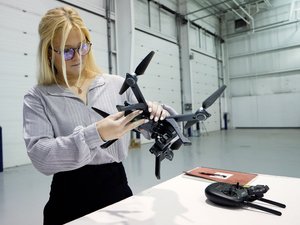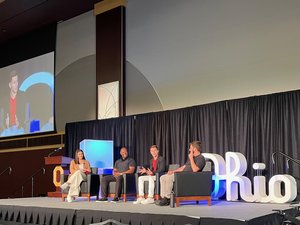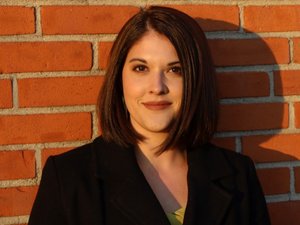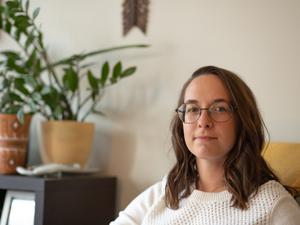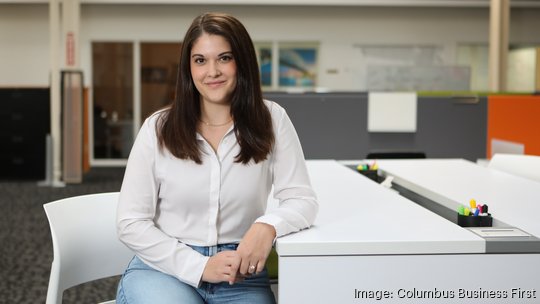
Rehgan Avon felt the time had come to start her own company.
She’d been thinking about it for a while, reflecting on the ways artificial intelligence was impacting businesses and the unsolved issues she saw across industries. So she made the jump, putting in her notice and readying for her next phase.
In February of 2020.
Of course, that’s when the whole world changed.
The arrival of the Covid-19 pandemic made Avon one of scores of female business owners who took the dive into entrepreneurship during a seismic shift in the global economy.
As part of our coverage of National Women’s Small Business Month, we sat down with Avon to talk about her journey and her experience so far. You can hear our conversation in our latest Women of Influence podcast.
Or read on for the highlights of our conversation, edited for clarity and length.
Tell me the story of your company. How did you decide to start it? And what do you do? I have been in the artificial intelligence space for almost a decade now, which I feel like is a long time at this point. And I’ve always worked at startups. I’ve taken on a lot of technical roles in my career, grew a huge passion for trying to figure out how to make AI more user-friendly and get people to participate in the process of creating and designing AI.
My co-founder and I worked at a startup together called ModelOp out of Chicago. We were working with enterprise organizations to help them deploy, test, model, monitor and manage machine learning models. And we recognized a huge issue. ... The biggest problems in AI were around people and process. We knew we wanted to start a company around that, we just weren’t sure when.
I was working for a startup in Columbus after ModelOp for about six months and decided to quit my job to start AlignAI. I put in my two weeks on Feb. 28 of 2020. I had no idea that a pandemic was going to shut everything down. And my last day of work was Friday, March 13. It was crazy. I did not know what I was getting myself into.
I gave myself a couple of months of breathing room just to figure out what was happening at a macro level before really launching this thing. And then just dove right in.
Our first customer was COTA, which was a really fun project to support and help them maintain their capacity to get essential workers to their jobs.
Can you expand a bit on what you mean by a people and process problem? The first thing we are seeing is a cultural challenge at companies. You have people who are doing their day-to-day operations ... and their sole focus is not data, it’s getting their job done.
That creates a really interesting challenge for companies because they actually have to collect different types of data that aren’t necessarily operational. And that means you need to get non-technical individuals to care about data, and to participate in the process.
Where are you bringing to clients? A technological solution, consulting services? A little bit of both. We do a ton of education. We do some consulting services to help guide, create some road maps, help people with kind of gap analyses of where they’re at and where they want to be in terms of maturity.
And then we also have a platform that basically helps them build out all of their policies and procedures around data and AI ... and helps them govern it from a people perspective.
So where is the company today? We’re three years old ... which is very exciting. We spent the first two years really focusing on services and market research. So we were like, ‘Do we need to build a product for this problem? Would people pay for this product?’
We were working with large Fortune 1000 enterprise organizations on the consulting side, just trying to understand what’s our entry point to this market, and then generative AI happened. So I’m glad we waited because I think we have maybe a little bit different positioning now than we did when we first set out to build this company. About a year ago, we started building our product, we started doing more in-depth user research.
And we actually are closing our first round, which is super exciting. And we are about 15 people at this point who are working on it.
Take me back to what it was like working through those uncertain days of the pandemic, building the business – did that have an effect on any decisions you made or approaches that you took? I think I was fortunate in the sense that my job can be very digital and I can work from home. So that made what we do at least sustainable during that time.
In addition to that, I think what the pandemic did for a lot of companies, if there is a bright side to that at all ... is it forced them to be reliant on data to make certain decisions.
For a long time, companies haven’t prioritized leveraging data, because it’s hard. There’s a lot of foundational investment you have to make. And you can make decisions like you always have without data and get at least far enough. Companies have been doing that for a long time.
I think what the pandemic did was reinforced this idea of data, because we were real-time reacting to changes.
I’ll use COTA as an example. Taking certain buses out of the route, or reducing capacity by 50% on their buses, what sort of impact is that going to have on certain demographics of individuals who do not have vehicles and need to get to their job?
But they also had a reduction in the amount of people that could work and drive the buses. So this becomes a data challenge.
And their C-level was highly interested in making sure that it was basically optimized for what was happening.
Did you always expect start a company? For the longest time, I was like, absolutely not. Because I kind of watched my CEOs that I would work under and I was like, that looks terrible. Just because it’s a lot.
(But) I grew a huge passion for startups, because the sky’s the limit. You can do whatever you want. And that was always really appealing to me. For a long time, my excitement grew out of watching other people create a vision and helping them execute against that vision. So that’s always been super fun for me.
I grew antsy and frustrated over the years and was so passionate about this one idea for probably three years before I thought about even starting a company around it. And that drive and frustration really tipped me over the edge. I never thought I would actually do it, to be honest with you.
You said you’ve been in AI for a decade. How is what’s happening today different than when you started? The whole field of artificial intelligence has been how do we replicate decisioning processes with computers. You can almost parallel everything in AI to people. We have memory, sort of like computers. We have logic that we intake, data through sight and sound and touch, and our brain processes to make decisions.
We’re basically trying to teach those types of patterns to computers so that computers can predict what might happen next and make decisions or augment decisions off of that.
We’ve all been experiencing AI through social media and Netflix, advertising. ... I think the field’s been super interesting, because this has been going on probably 50 years, 60 years and we’ve just not had enough data to do something interesting with. Now we’ve got people excited about it, which is even better.
